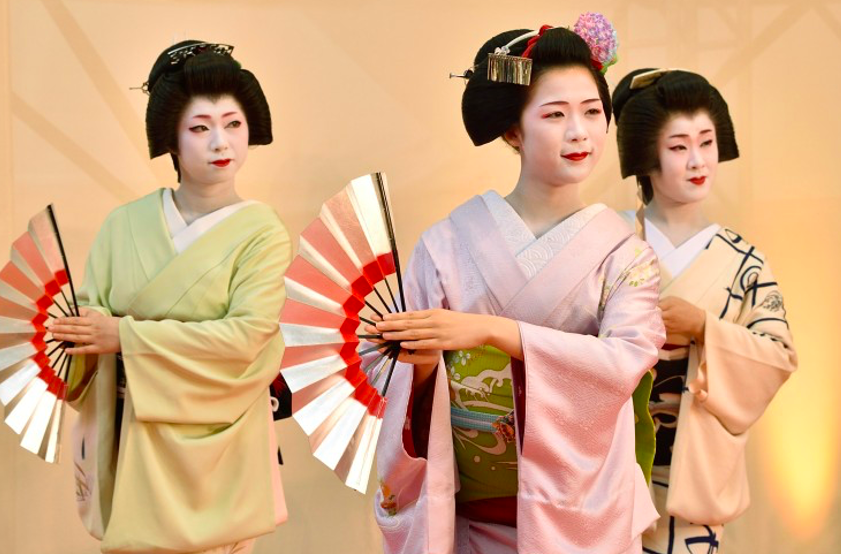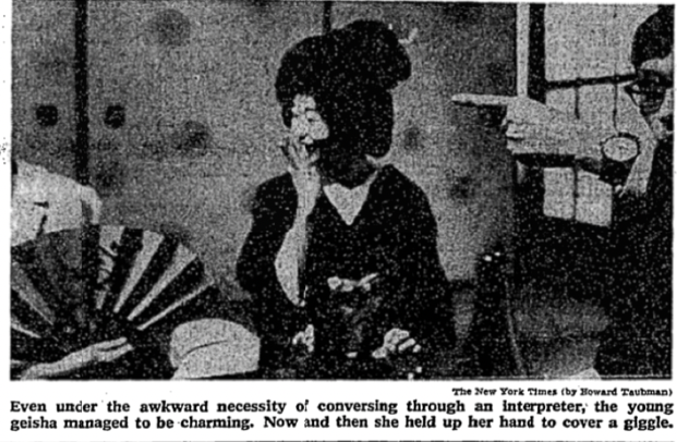Geisha are Japanese performing women, professionals in dance, hosting, and often various traditional instruments. They are usually recognisable from their stark painted white skin, bright red lips and customary kimonos, and are historically a staple of Japanese entertainment. Dating back hundreds of years, they could often be found working at teahouses or walking the streets of Kyoto’s Geisha District. Their primary clients were traditionally entirely male, yet the 21st century has transformed their company and performance into tourist favourites.

Geisha as we know them today are instantly recognisable figures – but our familiarity with them does not necessarily penetrate beyond the aesthetics. Geisha and their complex history are not popularly understood, yet they have historically acted as a staple of Japanese high-class entertainment, in their peak reaching populations of 80,000.
Yet the last 100 years have prompted the rapid diminishment of the industry. In my EPQ that I wrote last year, which was centred on the subject, I went into depth investigating the short-run causes of this diminishment. Yet most interesting are the long-lasting factors which have caused this number to fall drastically to a mere 600-700 in 1989 and predictably far less in the 21st century. Actually, the most significant factor for the decline of the Geisha industry is the emergence of female education and a change in gender equality in Japan.
Going back to the 18th century, pleasure quarters in Japan were the birthplace of the Geisha and came to be their most popular venue. Although the majority focused entirely on musical performance (‘Geisha’ translating to ‘drum-bearer’), the separation between Geisha and prostitute was unclear and the distinction is still often absent today. Thus, as Geisha moved away from pleasure quarters towards teahouses and private events, they weren’t exactly welcomed into society. In fact, a conflict arose immediately between the performing Geisha and the housewife. Geisha functioned as a sort of male escape from their domesticated wives, whom ‘do not satisfy husbands both recreationally and sexually, whereas these women [Geisha] do’. Although they commonly did not offer sexual entertainment, female Geisha still acted as subjects of desire for their clients. In contrast to the accessibility of their own wives, the company of a Geisha was desirable because of their unpossessable nature. These women became a threat to domestic life and prompted the publication of articles in women’s newspapers, such as in the monthly Japanese magazine Shufu no Tomo in the early 20th century, in which an article appeared advising wives on the secrets of preventing their husbands from being stolen by Geisha.

Yet the rise of feminism caused a complete turnaround by the mid 20th century. Constitutional changes in Japan and the rest of the world led to the rising position of women. In particular, Article 24 of the Japanese constitution signified the necessity in Japan, for the first time, of ‘equality of the sexes’ in marriage and relationships; it was increasingly becoming no longer socially acceptable for men to seek a sexual escape from their wives. In marriage, women were gaining equal footing with their husbands and there was no longer space for the sexual escapade of attending a Geisha event.
As well as the change in dynamics within the home, a large factor in Geisha’s falling popularity is to do with the rise in female education, as Howard Taubman noted in 1986 in the article entitled “Geisha Tradition Is Bowing Out in Japan”. A large factor in this rise in female education was, that in March of 1946, the United States employed a strategy for educational reform in occupied Japan, which included the ‘introduction of coeducation’, meaning that by 1952, there were approximately 47,000 women enrolled in four-year university courses.
This was significant because throughout the 19th and 20th centuries, many Geisha distanced themselves from spheres of prostitution and sexual entertainment and instead became known for their skills in hosting, companionship and conversation. In modern Japan due to the changes in female education, men no longer turn to the Geisha for ‘amiable female companionship’ because they could now ‘find it among their female peers’. Geisha experienced a significant loss of male customers who would now seek knowledgeable companionship elsewhere, since women were now given opportunity to match men academically.
These reforms further posed a problem to the structural foundations of the occupation. A Geisha before the war would begin training from a very young age, usually around 6 years old. Generally, this would last a minimum of 11 years; ‘Shikmi’ (foundational) for one year, ‘Misdashi’ for 4 to 5 years and ‘Eigae’ (in preparation for becoming a Geisha) for a final 6 to 7 years, making their debut as a Geisha around the age of 17 to 19. However, the 1952 mandatory ruling that children must attend an academic schooling of 9 years meant that normal full-time Japanese education would have to be taught prior to full-time 11-year training. Women who wanted to be Geisha would have train after formal education and not finish until adulthood, making the profession less desirable, especially since formal education widened the choices for female job opportunities.
Of course, the development of feminism and female empowerment in Japanese society is ultimately positive, but it does sew doubt about the future of the Geisha industry. Perhaps calling into question the continued existence of traditions across the world that seemingly disempower women. In just a few centuries their numbers have plummeted, and they have now become a stereotyped tourist attraction. Not only this, but in the era of globalisation, traditional Geisha culture is on the decline, and we can only hope that through historical and cultural appreciation the industry will live on.
